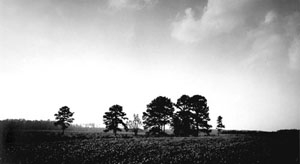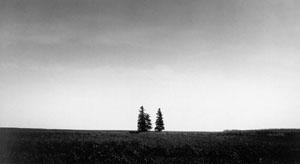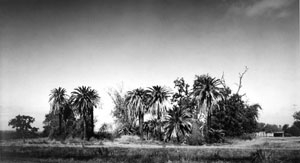Feature: Reviews
J. John Priola
- Gallery Paule Anglim
- San Francisco
- May 4 - May 28, 2005
Farm Sites and Other Works
J. John Priola’s exhibition “Farm Sites and Other Works” consists of gelatin-silver prints and a video projection. This series has been an ongoing project since 1999, recording Priola’s visits to farm sites in the U.S.A. Each work is photographed and printed by the artist himself. These decisions impact the enigmatic quality of Priola’s work.
At first glance, there doesn’t seem to be anything special about the places depicted in the series including Tower Road and Road 17. They don’t hold a prominent place on the map, nor are they noted historical sites. But soon, I am gracefully pulled in and wound around to experience scratching bark and feathered blades of grass. Fields raked as path draw me towards dilapidated trees and an immediate spatial lightness.
Although the sky holds much of the dominant space, I find myself with stretched out eyes, sinking into the darks and focusing on the slightly trampled emptiness of the space within the trees. The softness of the play of light and dark gently leads to a curious inquiry about this nonarbitrariness of place; to that which could have been erased, abandoned, or imagined.
I become conscious of a lingering man-made presence coexisting with the continuance of nature in this specific place. The trees are the remaining protective family. Fallen limbs have a history. Glimpses of this can be seen in the holes they leave and in the shelter that they once provided. Their organic indentations lightly outline the mysterious space within. Dirt is sunken from a lost weight. The emptiness provokes thoughts of shelter and occurrence. At once, the open sky is full.
The landscape has been both condensed and expanded due to the tampering with dimension and scale in the photographs. The chosen peculiarity of Priola’s cropping technique leaves me feeling as though my feet are soaking wet in the swamp pictured. With mud dampened toes, I am somehow a part of the scene without being seen. In actuality, I’m really not in close enough proximity to be having this experience. But I am having it.
Light douses the ground in resemblance of snow or dirt. I can’t tell what the climate is. The sky is clear. Trees are both dead and thriving. The farm site is barren and yet alive with simple and sparing oddity.
A grouping of smaller gelatin-silver prints, including Two Weather Stations, could be mistaken for ink drawings because of their stark white and black contrast. The quirky little protrusions of landscape look as though they could have been made by the travels of a wayward brush.
Whereas slight electrical lines may have marked the horizon in the larger photographs, here, a drastically elevated horizon line compresses the whiteness. The negative and positive spaces exist with equal importance. The once vast landscape has been whittled and simplified.
A projection of the Empire State Building, a bustling tourist attraction, rests in relative stillness on the top of the building. Yet my eyes are drawn downwards by windows and upwards in pursuit of spires. Sparkling light blinks out horizontally as clouds lazily drift along. This piece enforces the notion of seeing as an active experience.
J. John Priola presents contemplative places that could easily have gone unnoticed. These places, imbued with hints of existence and nonexistence, become increasingly mysterious. The play of contradictions, both aesthetically and conceptually, provides evidence for the role of the viewer, photographer, and the site itself. The stereotypical is transformed.
Prajakti Jayavant © 2005



